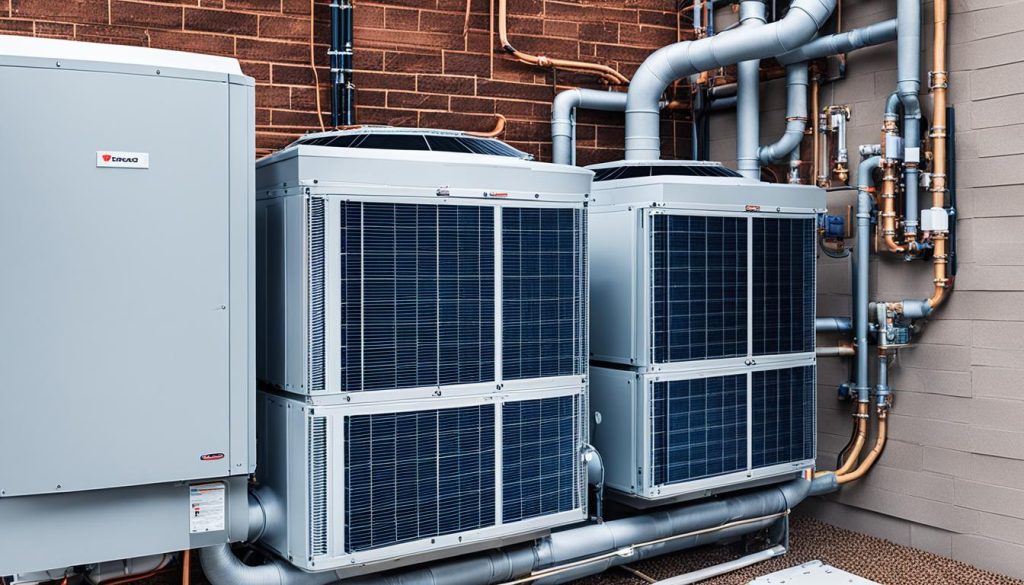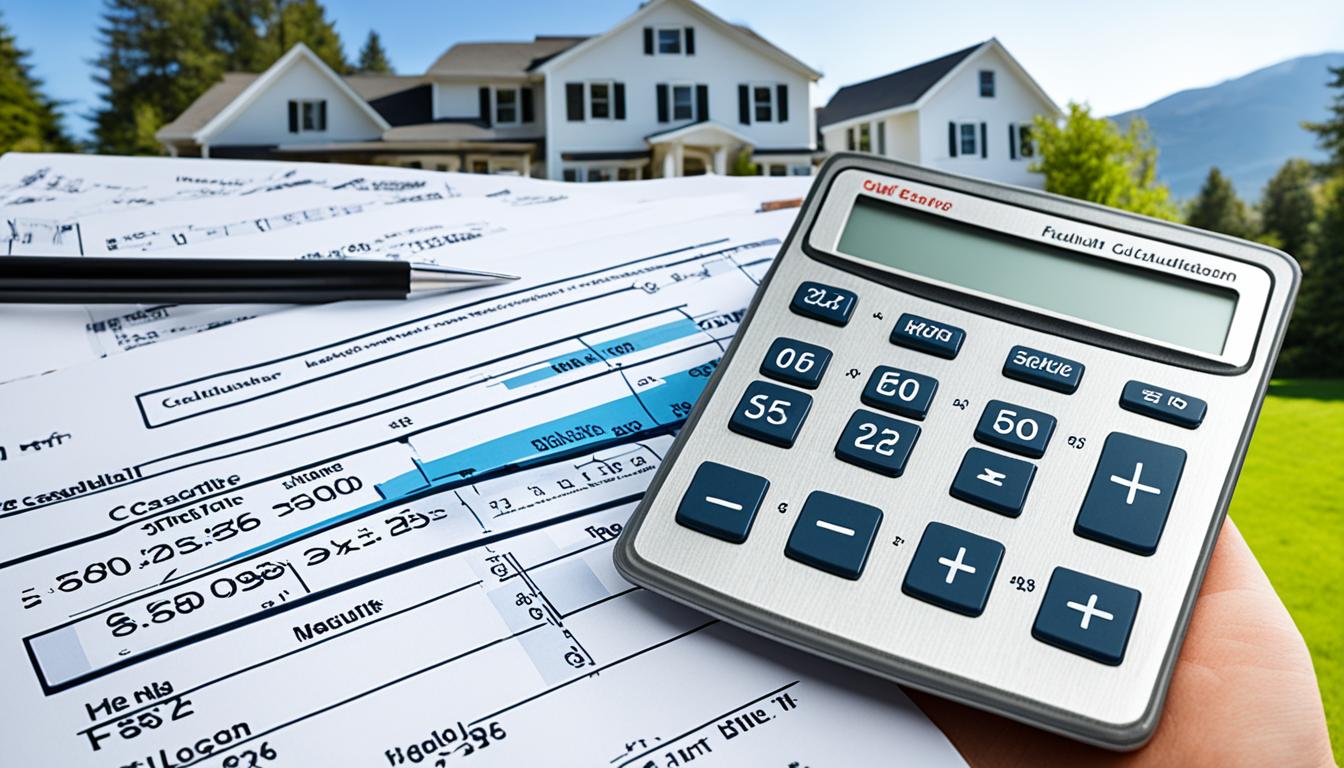Get ready for an energy-smart future with the Manual J Calculation Guide. This guide boosts your home’s HVAC by focusing on the right climate areas and checking your insulation. It also looks at how much sun your home gets, the number of people in your house, and the heat from appliances. All this info helps choose the best HVAC size for you.
The Manual J method combines the latest in cooling load calculations with digital tools. Adding it to your website makes sure the cooling load matches your area perfectly. This gets your HVAC system working at its best.
Key Takeaways
- Manual J Calculation optimizes HVAC design for energy efficiency.
- Factors include climate regions, insulation, sun exposure, and appliance heat.
- Recommends equipment capacities based on specific needs.
- Ensures digital integration with HVAC load calculation tools.
- Enhances comfort and performance through precise cooling load alignment.
Understanding Manual J Calculation
Doing a Manual J Calculation is important. It checks how much heating and cooling a home needs. This method helps make sure the air conditioner and heater are the right size for the home’s requirements.
Definition and Purpose
Manual J Calculation is a way for the HVAC industry to find out what a home needs. It looks at things like how much the sun hits the house, insulation, and heat from inside. This info is then used to choose the best HVAC system for keeping the home comfy.
Importance in HVAC Design
Using Manual J Calculation helps in making HVAC systems work well. It makes sure the system isn’t too big or too small. That way, the home stays pleasant and energy isn’t wasted. It also means the work meets building codes, which is good news for everyone involved.
| Aspects | Details |
|---|---|
| Air Conditioning Sizing | Ensures HVAC system meets specific home requirements |
| Heating and Cooling Load Calculation | Evaluates thermal characteristics for optimized performance |
| Compliance | Adheres to national building codes and standards |
Steps to Perform a Manual J Calculation
Doing a Manual J Calculation is key for the right HVAC size and better building operation. There are three main steps in this process. These steps help in making a HVAC design that saves energy.
Measuring Square Footage
First, get the exact size of the building. Leave out places like basements, attics, and garages. It’s very vital to get these measurements right for good building operation.
Assessing Insulation
Next, check how well the building keeps heat in. Look at the insulation in walls, ceilings, and floors. Also, think about how much air can leak out and how much sun comes in. These things all affect how well the HVAC system will work.

Evaluating Internal Space Usage
Last, think about who uses the building and the heat from appliances. This part is very important for understanding how much work the HVAC has to do. The right assessment makes sure the HVAC fits the building’s needs without wasting energy.
| Step | Description | Impact |
|---|---|---|
| Measuring Square Footage | Calculate exact living areas | Ensures accurate load calculations |
| Assessing Insulation | Evaluate insulation in walls, ceilings, and floors | Improves energy efficiency |
| Evaluating Internal Space Usage | Consider occupant count and appliance heat | Precisely determines HVAC load requirements |
Components of HVAC Load Calculation
Getting HVAC load calculations right means looking at many important parts. This helps make sure your system matches your building’s needs. Each part is crucial in figuring out the right HVAC size.
Heating Load
The heating load calculation checks how much energy you need to keep your place warm. It looks at things like your building’s insulation, windows, and the local weather. This makes sure your heating works well no matter the season.
Cooling Load
Knowing the cooling load is key for understanding how much energy is needed to cool your space. It considers things like the sun warming your place, appliances heating it up, and what people do inside. A proper cooling calculation helps your HVAC keep things cool even in heat waves.
Infiltration and Ventilation Loads
Dealing with air coming in and out, like in infiltration and ventilation, is part of HVAC loads too. Infiltration is about air sneaking in through your building’s cracks. Ventilation looks at bringing in air on purpose for health reasons. Getting these loads right is crucial in making a system that’s energy-efficient and keeps the air fresh.
Factors Influencing Manual J Calculations
Getting an HVAC load calculation just right needs knowing several important things. Every piece is key to figuring out how much heating and cooling a Residential HVAC design will need. This is vital for top-notch performance and comfy living.
Climate and Weather Conditions
The local climate and weather are key for any HVAC load calculation. They decide how much energy it takes to keep a house at the right temp. So, where it’s super hot or cold, bigger heating and cooling systems are a must.
Building Orientation and Sun Exposure
The way a house faces and how much sun it gets are also crucial for HVAC load calculations. Sunny sides need more cooling, while shady spots might need more heating. Factoring in these details helps design a home that’s both comfy and saves energy.
Occupancy and Appliance Heat Gains
Don’t forget about who lives in the house and the heat appliances give off. The more people and the often those appliances run, the more they add to your heating and cooling needs. This makes a system that can handle these extras very important.
So, thinking about these details from weather to how we live is key in making a good Residential HVAC design. They all work together to create a place that’s just the right temperature, saving energy in the process.
Manual J 8th Edition: What’s New?
The Manual J 8th edition has a big update. It makes HVAC load calculations more accurate and efficient. Now, it works better with specific local conditions.

Updated Design Conditions
The Manual J 8th edition now uses localized weather data in its calculations. This makes them more accurate. It reflects the real environmental factors that affect HVAC loads.
Adjustable Defaults for Local Conditions
The new thing in the Manual J 8th edition is adjustable defaults. Now, we can fine-tune load calculations for a local climate. This makes HVAC system design even better.
Software Interpolation Rules
The Manual J 8th edition also has new software rules. These rules calculate in-between values more accurately. That means HVAC load assessments done with software are more reliable too.
In short, the Manual J 8th edition gives HVAC pros more tools for better calculations. This leads to residential HVAC systems that work better and use energy more efficiently.
Common Mistakes to Avoid in Manual J Calculations
Manual J calculations are key for a great and efficient HVAC design. But, there are usual errors that might cause issues or inefficiency in your design. Let’s talk about these mistakes and how to dodge them.

- Neglecting Local Climate Conditions: Forgetting about local weather can mess up your HVAC load numbers. It’s crucial to tweak the figures for the weather in your area to get right answers.
- Incorrect Measurements: Mistakes in measuring room sizes, insulation, and windows can make your HVAC too big or too small. Always re-measure to keep your numbers spot on.
- Underestimating Occupancy and Internal Heat Gains: Not thinking about how many people, appliances, and devices impact the system’s performance is a mistake. You need these details for a good HVAC design.
- Ignoring Solar Heat Gains: We often forget how much the sun heats our spaces. Counting this heat in your calculations gives you a clearer picture of what cooling your place really needs.
- Overlooking Ventilation Requirements: Good airflow is important for clean air and comfort indoors. Make sure to include ventilation needs when calculating loads for a well-rounded HVAC system.
To make a top-notch, energy saving HVAC design, steering clear of these mistakes is vital. By being careful with your Manual J work, you can ensure an accurate, reliable, and eco-friendly HVAC setup for homes.
The Role of Manual J in Energy-Efficient HVAC Design
Manual J is key for efficient HVAC design. It figures out how much heating and cooling your home needs. This stops systems from being too big or too small. That’s good because it saves energy and cuts costs.
Optimizing Equipment Sizing
HVAC pros use Manual J to pick the right size equipment for homes. This step saves energy and money. It also lessens harm to the environment. Systems work better when they’re just the right size.

Improving Home Comfort
Manual J helps create better home comfort. It carefully sets up HVAC systems to make sure homes stay at a steady temperature. They also make the air cleaner. This makes living conditions a lot nicer, fitting with energy-saving design ideas.
Using Manual J in home projects covers every heating and cooling need. It looks at each room, the sun’s impact, and how people inside affect the temperature. These details are crucial for making homes cozy, green, and efficient.
Manual J Software Options
Moving from old tools to digital, Manual J software brings many good points. These tools make HVAC load calculations smoother. They also cut down on mistakes and keep data handy for later. Going digital fits well with the newest Manual J rules, making HVAC design and checks spot on.
Benefits of Using Software
Manual J software changes how HVAC experts do load math, making the job easier and more spot on. Plus, it brings these plusses:
- Error Reduction: Automated calculations cut down on human mistakes, giving you trustworthy outcomes.
- Efficiency: Makes doing the math faster, so HVAC designers save time.
- Data Storage: Makes old calculations easy to find, helping with future fixing and checks.
- Integration: Works well with other design programs, making workflow smoother.

Popular Manual J Software Tools
There are several top Manual J software choices. They each have special parts for your HVAC design work. Here are a couple that stand out:
| Software Tool | Key Features | Pros | Cons |
|---|---|---|---|
| Wrightsoft | Comprehensive load calculation, integration with Manual D and S | User-friendly interface, extensive support | Cost may be high for small businesses |
| CoolCalc | Cloud-based, compliant with Manual J 8th Edition | Accessible anywhere, easy updates | Requires internet connection |
| Elite Software RHVAC | Advanced load calculation, extensive customization | Diversified functionalities, detailed reports | Steeper learning curve |
Using Manual J software helps make sure your HVAC plans are right, effective, and meet today’s rules. The Manual J Calculation Guide points this out.
The Impact of Proper Load Calculation on Building Performance
Getting the right load calculation for HVAC systems is key. It boosts performance and makes your HVAC equipment last longer. This is because a precise design means your HVAC works smarter, not harder. It cuts energy use and improves your system’s life span.
Enhanced System Efficiency
Using proper load calculations helps your HVAC work better. This lowers energy waste and cuts costs. A right-sized HVAC system runs smoothly, keeping indoor temps steady. It also doesn’t need to start and stop as often. As a result, you save on bills and help the planet by using less energy.
Prolonged Equipment Lifespan
Accurate load calculations are good for your HVAC’s health. They prevent systems from being overworked or too big for their spaces. This means less wear on parts, fewer breakdowns, and less need for repairs. Your HVAC units will last longer and perform better. In the end, these building performance calculations make sure your HVAC investment is worth it.
| Benefits | Enhanced System Efficiency | Prolonged Equipment Lifespan |
|---|---|---|
| Reduced Energy Costs | ✔ | ✔ |
| Consistent Indoor Climate | ✔ | |
| Lower Carbon Footprint | ✔ | |
| Minimized Wear and Tear | ✔ | |
| Reduced Maintenance Costs | ✔ |
Manual J Calculation Guide: Best Practices
For accurate Manual J calculations, use precise data collection and follow set steps. This way, your HVAC load calculation becomes trustworthy. Your home’s HVAC design will then exactly match what it needs.
Accurate Data Collection
Getting the right data is key for a good Manual J Calculation Guide. You need to measure your home’s size, check the insulation, and more.
- Measure Room Dimensions: Be sure to measure each room’s height, width, and length. This includes walls, windows, and doors.
- Evaluate Insulation: Look at the insulation in walls, roofs, and floors. This helps know how well your home can keep in heat.
- Assess Window Efficiency: Check the size, type, and how well windows keep heat in. This tells you about heat gains and losses.
- Consider Airtightness: Find and fix any air leaks to see how tight your home is. This affects your HVAC systems’ needs.
These steps use real and solid data. This makes your HVAC load calculation reliable.
Using Standardized Procedures
Using set procedures makes sure your Manual J calculations are always right. It is key to follow the ACCA (Air Conditioning Contractors of America) guidelines.
| Procedure | Description | Benefit |
|---|---|---|
| Room-by-Room Calculation | Calculates loads for each room individually | Ensures precise load distribution throughout the home |
| Total System Load | Aggregates individual room loads to determine total HVAC need | Ensures system sizing matches overall demand |
| Climate Data Integration | Incorporates local weather data | Improves accuracy by reflecting real climate conditions |
| Occupancy and Appliance Considerations | Accounts for heat gains from occupants and appliances | Reflects internal heat dynamics for accurate load calculation |
Combine accurate data collection with the right procedures. Your Manual J Calculation Guide will boost your HVAC system. This improves your home’s efficiency and comfort.
Conclusion
The Manual J Calculation Guide helps make home HVAC systems energy-efficient. It guides you to choose the right size equipment for your house. This means your system works better, costs less to run, and makes your home more comfortable.
It looks at things like your area’s climate, the size of rooms, how well they’re insulated, and the heat from people and things. By understanding and using these details, your HVAC plan will be top-notch and good for the planet.
Following the Manual J Calculation Guide means you really get your house’s needs. This lets you pick options that not only work well but save energy. So, you can enjoy a cozy home that doesn’t waste power, feeling good about your choices.





0 Comments